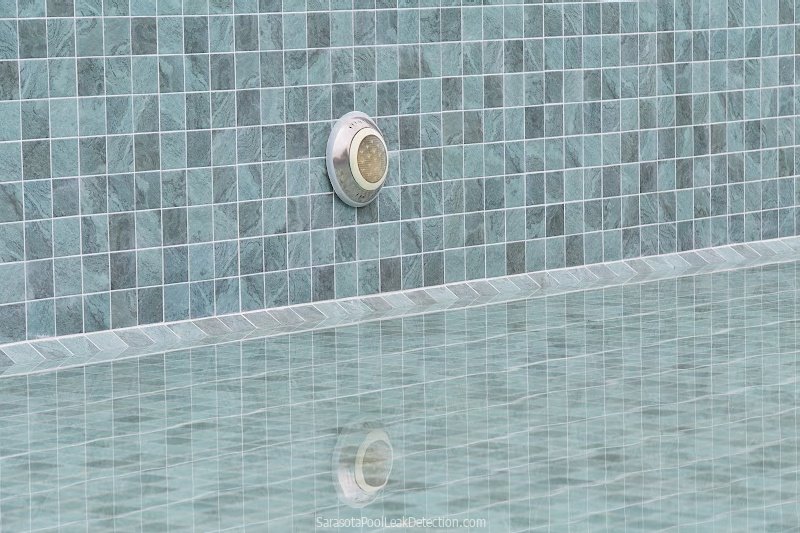If you notice that your inground pool loses more than an inch of water a day, you may have a pool leak.
There are many possible pool leak locations. Because of this, it’s overwhelming for pool owners to figure out where to start looking.
We’ll give you a hint. The pool skimmer is the most common pool leak area.

These are the most common locations of pool skimmer leaks:
- Poor plumbing seals: Found between fittings and skimmer threads
- Cracked tiles: Found in the skimmer throat where the plastic skimmer and the concrete pool shell meet
To confirm the location of pool skimmer leaks, you need to conduct a dye test.
In this guide, find out how exactly to locate pool skimmer leaks.

How Do Pool Skimmers Get Leaks?
Pool skimmer leaks are the most common type of pool leaks in in-ground gunite pools. How the pool skimmer was installed will affect the likelihood of a pool leak.
Here are the most popular pool skimmer installation methods:
- Method 1: The skimmer is directly placed onto the steel frame of the pool wall. The entire skimmer and the pool frame are encapsulated in concrete. This is a leak-proof way to install skimmers.
- Method 2: This is a common way to install skimmers. The pool contractor drills notches into the pool wall, where the skimmer will go. After the gunite is completed, the installer uses the pegging method to attach the skimmer to the pool wall. The installer pours hydraulic cement to hold the skimmers to the pool wall.
The second method is more problematic and prone to leaks. This is because it’s easily affected by shifting soil and the freeze/thaw cycle. This causes a cold joint between the gunite and hydraulic concrete.
This small separation between hydraulic concrete and gunite is enough to cause cracks and breakage along the pool wall and skimmer.
Please include attribution to https://sarasotapoolleakdetection.com with this graphic.
Detecting Pool Skimmer Leaks
Most of your pool water passes through the skimmer. If you don’t detect and fix it immediately, expect significant structural damage to your pool.
1. Switch Off Your Pool Pump
Make sure to turn off your pool pump before conducting leak tests. This will make it easier for you to inspect the skimmer box area.
2. Replace Water Loss
If your pool has been leaking for quite some time, the water level in your pool is probably well below the skimmer box.
To detect a skimmer leak, it needs to be submerged in water, especially if you’re doing the dye test.
Add more water to your pool until the water level is an inch higher where the pool wall meets the skimmer box.
3. Remove the Skimmer Cover
To inspect the skimmer, you need to look into the skimmer’s throat. Remove the cover by disengaging screws, plastic snaps, or handles.
This will make it easier for you to find the leak.
You can also check our blog here about detecting pressure side leaks.

Step-by-Step Guide: How Do You Find a Leak in a Pool Skimmer?
Before calling your local pool service professional, you can try to detect the leak through visual inspection or the dye test.
1. Mark the Side of the Pool
Leave a marker on your pool wall to indicate the water level. You can use a pencil or masking tape for this.
Closely monitor the water level over several days. If you notice that the water level dips several inches in the following days, you can suspect a leak.
2. Inspect All Possible Leak Sites
Does your pool’s water level stop right at or just below the mouth of the pool skimmer? If that’s the case, you most likely have a pool skimmer leak.
To find the exact source of the leak in your skimmer, turn off the pool pump, take off the skimmer lid, and remove the pump basket, the skimmer weir, and the diverter.
Check if there are leaks in these equipment.
3. Visually Inspect the Skimmer for Pool Cracks and Breaks
As mentioned, the most common location for skimmer leaks is between the skimmer and the concrete shell.
Look into the skimmer’s throat for cracks or breaks in the pool tiles. Pay close attention to the corners and the seals between the plastic skimmer and the concrete.
4. Visually Inspect the Plumbing Seals
The plumbing seals in the skimmer are another common pool leak location.
Look down into your skimmer; you should find one or two holes at the bottom. This is where your skimmer is connected to the pool plumbing.
The leak is most likely in the seal between the fittings and skimmer threads.

5. Conduct a Dye Test
It can be hard to find the exact location of leaks in steps 3 and 4.
To help you find the leaks, conduct the dye test:
- Fill an eyedropper with red dye.
- Apply the red dye to the suspected pool cracks or the plumbing seals.
- If the dye is suddenly pulled into the suspected crack, you have a skimmer leak.
Call (561) 570-1269 now, and we will schedule a pool repair and renovation company in your area to reach out to you. They will schedule a time convenient for you to stop by and give you a bid on the repairs.
Or you can fill out this form, and we will have the best pool renovation company in your area contact you!
In case you can not view this video here, please click the link below to view Where Does a Pool Skimmer Usually Leak? | Nelson Pool Company on my YouTube channel: https://youtu.be/fa7SS_2QD54
